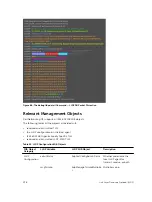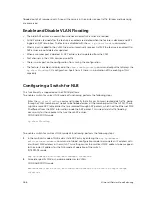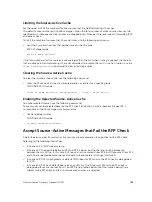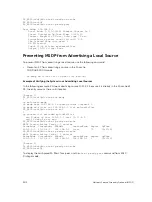
Anycast RP
Using MSDP, anycast RP provides load sharing and redundancy in PIM-SM networks. Anycast RP allows
two or more rendezvous points (RPs) to share the load for source registration and the ability to act as hot
backup routers for each other.
Anycast RP allows you to configure two or more RPs with the same IP address on Loopback interfaces.
The Anycast RP Loopback address are configured with a 32-bit mask, making it a host address. All
downstream routers are configured to know that the Anycast RP Loopback address is the IP address of
their local RP. IP routing automatically selects the closest RP for each source and receiver. Assuming that
the sources are evenly spaced around the network, an equal number of sources register with each RP.
Consequently, all the RPs in the network share the process of registering the sources equally. Because a
source may register with one RP and receivers may join to a different RP, a method is needed for the RPs
to exchange information about active sources. This information exchange is done with MSDP.
With Anycast RP, all the RPs are configured to be MSDP peers of each other. When a source registers with
one RP, an SA message is sent to the other RPs informing them that there is an active source for a
particular multicast group. The result is that each RP is aware of the active sources in the area of the
other RPs. If any of the RPs fail, IP routing converges and one of the RPs becomes the active RP in more
than one area. New sources register with the backup RP. Receivers join toward the new RP and
connectivity is maintained.
Implementation Information
The Dell Networking OS implementation of MSDP is in accordance with RFC 3618 and Anycast RP is in
accordance with RFC 3446.
Configure Multicast Source Discovery Protocol
Configuring MSDP is a four-step process.
1.
Enable an exterior gateway protocol (EGP) with at least two routing domains.
Refer to the following figures.
The
show the OSPF-BGP configuration used in this chapter for MSDP.
Also, refer to
Open Shortest Path First (OSPFv2)
Border Gateway Protocol IPv4 (BGPv4)
2.
Configure PIM-SM within each EGP routing domain.
Refer to the following figures.
The
show the PIM-SM configuration in this chapter for MSDP. Also,
refer to
.
3.
4.
Peer the RPs in each routing domain with each other. Refer to
Related Configuration Tasks
The following lists related MSDP configuration tasks.
•
•
Manage the Source-Active Cache
Multicast Source Discovery Protocol (MSDP)
489
Summary of Contents for Z9000
Page 1: ...Dell Configuration Guide for the Z9000 System 9 7 0 0 ...
Page 80: ...grub reboot 80 Management ...
Page 128: ... 0 Te 1 1 Te 1 2 rx Flow N A N A 128 Access Control Lists ACLs ...
Page 491: ...Figure 70 Configuring OSPF and BGP for MSDP Multicast Source Discovery Protocol MSDP 491 ...
Page 496: ...Figure 73 MSDP Default Peer Scenario 1 496 Multicast Source Discovery Protocol MSDP ...
Page 497: ...Figure 74 MSDP Default Peer Scenario 2 Multicast Source Discovery Protocol MSDP 497 ...
Page 498: ...Figure 75 MSDP Default Peer Scenario 3 498 Multicast Source Discovery Protocol MSDP ...
Page 760: ...Figure 100 Single and Double Tag TPID Match 760 Service Provider Bridging ...
Page 761: ...Figure 101 Single and Double Tag First byte TPID Match Service Provider Bridging 761 ...
















































